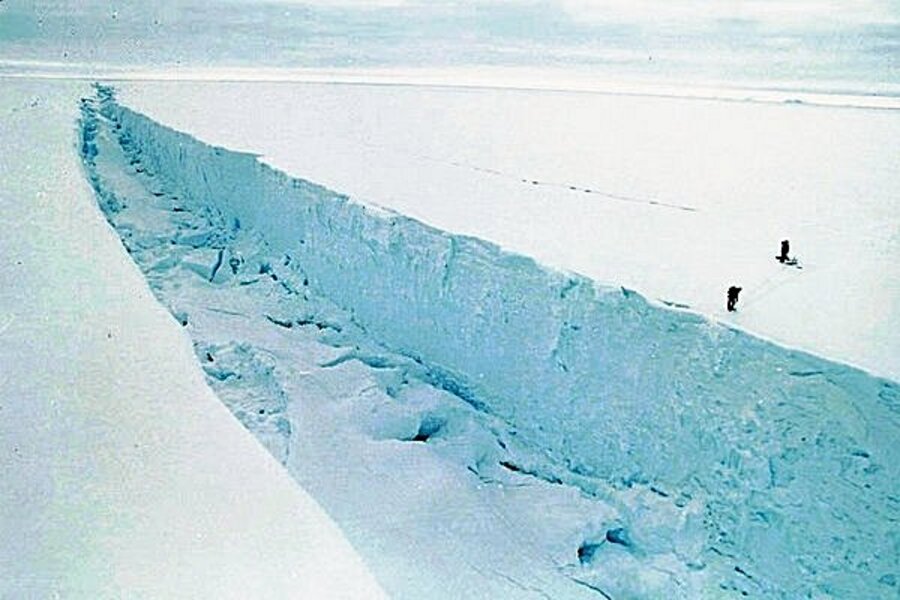Warm water threatens vast Anatarctic ice shelf
Loading...
| LONDON
Scientists are predicting the disappearance of another vast ice shelf in Antarctica by the end of the century that will accelerate rising sea levels.
The Filchner-Ronne Ice Shelf fringing the Weddell Sea on the eastern side of Antarctica has so far not seen ice loss from global warming and much of the observation of melting has focused on the western side of the continent around the Amundsen Sea. But new research from the Alfred Wegener Institute for Polar and Marine Research in Germany says the 450,000-sq-km ice shelf is under threat.
"According to our calculations, this protective barrier will disintegrate by the end of this century," said Dr Harmut Hellmer, lead author of the study, published in the journal Nature this week.
The huge ice shelves that float on the seas fringing Antarctica provide a buffer against warming waters eating away at the base of the much larger glaciers behind them that sit on the land.
"Ice shelves are like corks in the bottles for the ice streams behind them," said Hellmer. "They reduce the ice flow.
"If, however, the ice shelves melt from below, they become so thin that the dragging surfaces become smaller and the ice behind them starts to move."
Hellmer and his team predict the melting of the Filchner-Ronne shelf could add up to 4.4 mm per year to rising global sea levels.
According to the latest estimates based on remote sensing data, global sea levels rose 1.5 mm a year between 2003 and 2010 due to melting glaciers and ice shelves, the scientists say. This is on top of an estimated 1.7 mm annual rise due to the expansion of the oceans as the water warms.
Costly Sea Defences
The research was funded by the European Union's ‘Ice2sea' program, set up in the wake of the 2007 report by the Intergovernmental Panel on Climate Change that highlighted ice-sheets as the most significant remaining uncertainty in projections of rising sea levels. Projections from the Ice2sea project will feed into the fifth IPCC report due in 2013/2014.
It will also inform plans for major capital spending on sea defenses to protect Europe's coastlines, particularly areas of economic importance like London, with its tidal barrier on the River Thames, and the port of Rotterdam. A large part of the Netherlands is below sea level and protected by an elaborate system of dykes.
Professor David Vaughan of the British Antarctic Survey, who heads the Ice2sea program, told Reuters the Alfred Wegener Institute's findings add to evidence that warming oceans are having the greatest impact on the ice sheets, as opposed to atmospheric changes or the legacy of some long-term change decades or even hundreds of years ago.
"What people need to know with a sense of urgency is what is going to happen to sea levels over the next few decades," said Vaughan. "In those terms, these results are very big news indeed."
Vaughan is cautious about precise projections of the impact on sea levels. "For me, those numbers are about what might be plausible," he said. "I think we need to do some more work with the ice sheet models to determine exactly what sea level rises we might expect, but those are plausible numbers."
All other things being equal, the polar ice sheets reach a balance where the amount of snow going in each year is broadly matched by the number of icebergs coming out, but subtle changes like those associated with global warming, can affect that balance quite rapidly.
Vaughan said there was clear evidence that the widely-reported disintegration of the Larsen A and Larsen B ice shelves in 1995 and 2002 respectively, had led to the ice sheets that fed them moving faster into the sea, some of them many times the rate seen before collapse.
The scientific focus on the melting ice in the Amundsen sea is down to the fact that this is where it is happening now, but Vaughan said although the Weddell
Sea is not seeing ice loss at the moment, the German research supports the view that it will spread to other areas.
If there is a lesson for climate scientists, it's "don't behave like the infant school football team and follow the ball," he said.





